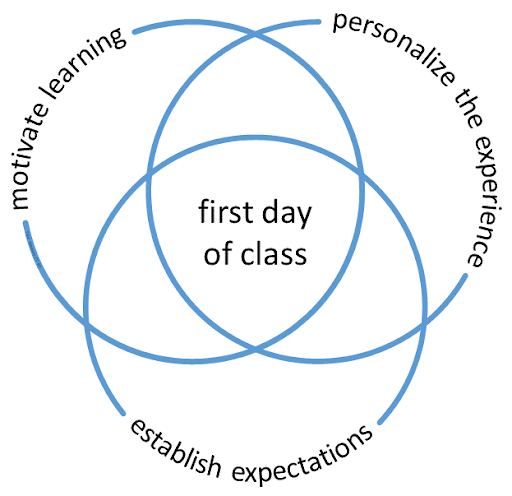What you do on your first day of class establishes the learning environment for the rest of your course, so it’s critical to think and plan carefully.

- You want every student to leave the first class thinking:
- This will be a good course.
- I’m okay, I’m safe being here.
- I have something valuable to contribute.
- Therefore, resist the urge to simply “go over the syllabus” or launch right into Topic 1.
- Instead, plan a first day that includes significant time spent engaging with others.
- Share expectations considering what students want to know most about:
- What they will be learning about and why it matters
- What the workload is like in terms of time and also the work they will be asked to produce
- What the participation expectations are
- How they will be evaluated
- What you are like as an instructor: are you accessible? are you flexible? will you be someone they can approach if they are lost or in trouble?
As you explain your expectations, be explicit and specific whenever possible. Don’t leave room for interpretation, and encourage questions. You might even ask students to write briefly anonymous questions on scraps of paper that you can collect and work through.
5. Foster a climate of meeting expectations through smart behaviors by joining the Strong Student Campaign and showing one slide each day your class meets.
Choose an introductory activity that will engage students in your subject and help them to know one another.
Download this list and print this Venn diagram [reproduced above]. For each item A, B, C,… (and others you add to the list) decide for yourself if the item motivates learning, personalizes the experience for the student, and/or establishes expectations. When you’re done, perhaps the items at the center of the Venn diagram – the items that do all three simultaneously – are the ones to build into your first class. That way, you can be the most efficient and effective in the limited time you have with your students.
What you do (and don’t do) in your first class is up to you, of course. Here are some first day of class do’s and don’ts for you to consider.
| DO |
DON’T |
Check out the classroom before the first class
- fully connect and test your laptop
- using clickers? connect and test the hardware and software
- how do you log into the podium/lectern computer, if needed?
- what’s the wifi like, even in the back corners?
- how do the classroom lights work?
- try the lapel (“lav”) mic
- are you using a presentation remote to advance your slides? Does it work from the back of the room?
|
- Assume you can figure it out at the time
- let a technical problem ruin your only chance to make a first impression
|
| Start the class on time (establish expectations!) |
- arrive late (what expectation does that establish!)
- have “intimate” conversations with the (enthusiastic) students who arrive early and sit in the front row. This can signal to the rest of the class who will be getting special attention. Instead, circulate around the room and speak with lots of students, or greet everyone at the door.
|
Tell students you think they can all succeed if they put in the effort (growth mindset). It’s fine to say the course is challenging (after all, shouldn’t it be?) as long as you also let them know the course is
- interesting
- valuable
- achievable with appropriate effort
|
Say threatening things like:
- you expect some of them to fail (“Look left, look right – one of you won’t be here by the end of the course.”)
- this is a “weed-out” or “gatekeeping” course (to get rid of students who shouldn’t continue to the next course)
- students don’t usually like this course
- this course is really hard
|
Give them an authentic experience of what the class will be like.
- If you’re going to use peer instruction with clickers, do it even though not everyone has a clicker yet. If awarding participation points is part of your plan, don’t start that until Week 2.
- If you’re going to flip your class, send them a pre-reading assignment (and welcome) before the first day.
- If you’ll be asking them to discuss challenging issues and items in small groups throughout the course, do it in the first class, too, maybe as an icebreaker.
|
Use teaching practices that are inconsistent with how you’ll teach the rest of the course. |
| Model academic integrity, today and every day. Address it when it’s needed: discuss plagiarism in Week 3 when you assign the first essay. |
Emphasize penalties for academic misconduct and all the ways a student can be kicked out of the university.
- It establishes a feeling of distrust
- Now is not the time they need to be hearing this. It’s important, yes, but not right now.
|
End the class on time with a slide containing the most valuable information, just in case a lost student missed the first few minutes of the class:
- your preferred name
- office location and hours
- contact info
- course website
- Important Thing
|
End the class early (establishes the wrong expectation) or end the class late (be kind to your anxious, exhausted colleague who’s trying to get into the classroom to set up their first class!) |
| Repeat vital information (your preferred name, contact info, Important Thing) at the begin of second class |
|
“Planning Your First Day of Class” by Peter Newbury is licensed under a Creative Commons Attribution 4.0 International License, excerpted.
Last Modified: Thursday, January 2, 2025 11:24 am
EJI
For more information or help, please email the Office for Faculty Excellence or make an appointment with a consultant.

